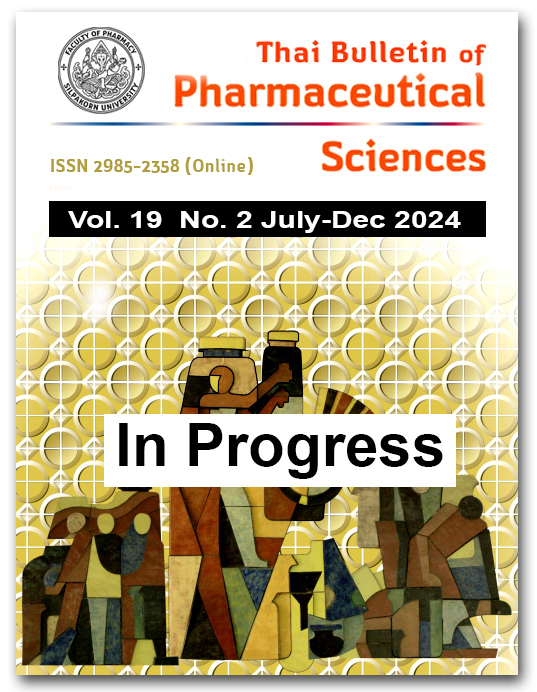DEVELOPMENT OF FLUCONAZOLE-LOADED POLY(VINYL ALCOHOL)/POLY(ETHYLENE GLYCOL) BLENDED FILM FOR TREATMENT OF CANDIDA-INFECTED CUTANEOUS WOUNDS
DOI:
https://doi.org/10.69598/tbps.19.2.221-229Keywords:
fluconazole, poly(vinyl alcohol), poly(ethylene glycol), films, candidiasisAbstract
In this work, we aimed to develop fluconazole (FLU)-loaded polymer blended film (FLU-film) for candidiasis wounds. The films were prepared from poly(vinyl alcohol) (PVA) and poly(ethylene glycol) 1000 (PEG 1000) mixed at different proportions by weight, casted on a petri dish, and dried at 60ºC for 12 h. Tensile strength, swelling ratio, and morphology were analyzed to determine an appropriate film for wound application. The selected film was loaded with 0.5% w/w FLU, where the drug homogeneity was ascertained. Then, the drug release profile, cytotoxicity of the films, and antifungal activity were determined. The findings revealed that the suitable film was PVA:PEG 1000 (95:5), showing anticipated flexibility and stretchability, as well as a soothing texture, while the swelling and molecular attributes were comparable to other films. FLU was homogenously loaded into the selected film and presented a prolonged release profile following Higuchi’s model. The film was found to be non-toxic to the human skin fibroblast. Lastly, the FLU-film presented 1.16-fold greater antifungal effectiveness than the free FLU. Overall, the FLU-film has been developed and proven to be effective for treating Candida-infected wounds.
References
Aye. KC, Sahatsapan N, Panomsuk S, Nattapulwat N, Aumklad P, Patrojanasophon P, et al. Fabrication and evaluation of chlorhexidine gluconate-incorporated chitosan-poly (vinyl alcohol) hydrogel films for infected wounds. Thai Bull Pharm Sci. 2023;18:39-48.
Palese E, Nudo M, Zino G, Devirgiliis V, Carbotti M, Cinelli E, et al. Cutaneous candidiasis caused by Candida albicans in a young non-immunosuppressed patient: An unusual presentation. Int J Immunopathol Pharmacol. 2018;32:2058738418781368.
Pappas PG, Kauffman CA, Andes DR, Clancy CJ, Marr KA, Ostrosky-Zeichner L, et al. Clinical practice guideline for the management of candidiasis: 2016 Update by the Infectious Diseases Society of America. Clin Infect Dis. 2016;62(4):e1-50.
Salerno C, Carlucci AM, Bregni C. Study of in vitro drug release and percutaneous absorption of fluconazole from topical dosage forms. AAPS PharmSciTech. 2010;11(2):986-93.
Washton H. Review of fluconazole: A new triazole antifungal agent. Diagn Microbiol Infect Dis. 1989;12(4):229-33.
El-Housiny S, Shams Eldeen MA, El-Attar YA, Salem HA, Attia D, Bendas ER, et al. Fluconazole-loaded solid lipid nanoparticles topical gel for treatment of pityriasis versicolor: formulation and clinical study. Drug Deliv. 2018;25(1):78-90.
Gaire A, Pharm B, Maharjan S, Shrestha S, Pharm M, Pakhrin S, et al. Formulation & evaluation of fluconazole gel for topical drug delivery system. ASRJETS. 2021;76(1):124-37.
Sussman G. Technology update: Understanding film dressings. Wound Int. 2010;1(4):23-5.
Tenorová K, Masteiková R, Pavloková S, Kostelanská K, Bernatonienė J, Vetchý D. Formulation and evaluation of novel film wound dressing based on collagen/microfibrillated carboxymethylcellulose blend. Pharm. Pharmaceutics. 2022;14(4):782.
Jin SG. Production and application of biomaterials based on polyvinyl alcohol (PVA) as wound dressing. Chem Asian J. 2022;17(21):e202200595.
Chen SL, Fu RH, Liao SF, Liu SP, Lin SZ, Wang YC. A PEG-based hydrogel for effective wound care management. Cell Transplant. 2018;27(2):275-84.
Chabay RW, Sherwood BA. Matter and interactions. 3rd ed. Indiana: Wiley; 2011.
Ma YZ, Sobernheim D, Garzon JR. Chapter 19 - Glossary for unconventional oil and gas resource evaluation and development. In: Ma YZ, Holditch SA, editors. Unconventional oil and gas resources handbook. Boston: Gulf Professional Publishing; 2016. p. 513-26.
Ngadaonye J, Geever L, Killion J, Higginbotham C. Development of novel chitosan-poly (N, N-diethylacrylamide) IPN films for potential wound dressing and biomedical applications. J Polym Res. 2013;20:161.
Grant SM, Clissold SP. Fluconazole. Drugs. 1990;39(6):877-916.
Setyawan D, Dewi MY, Isadiartuti D. Ternary solid dispersion to improve solubility and dissolution of meloxicam. J Basic Clin Physiol Pharmacol. 2019;30(6):20190244.
Downloads
Published
How to Cite
Issue
Section
License
All articles published and information contained in this journal such as text, graphics, logos and images is copyrighted by and proprietary to the Thai Bulletin of Pharmaceutical Sciences, and may not be reproduced in whole or in part by persons, organizations, or corporations other than the Thai Bulletin of Pharmaceutical Sciences and the authors without prior written permission.



